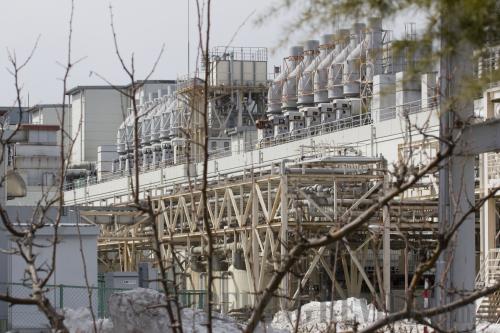|
 |
|
PRODUCTION HALT: A factory of Fujitsu Semiconductor shuts down in Aizuwakamatsu, Fukushima on March 17, as a result of Japan's earthquake and the Fukushima nuclear radiation (CFP) |
The recent massive earthquake in Japan—a highly advanced economy in terms of industry, exports and assets—is having a sweeping impact on the global economy.
The biggest impact on the real economy has been production suspension and price hikes caused by the earthquake. Japan is the world's major provider of intermediate inputs and manufacturing equipment in the advanced manufacturing sector, especially in automobiles and electronics products. Unfortunately, the electronics industry was the one hit most severely this time.
Though Japan's two key economic regions, Tokyo-Yokohama and Osaka-Kobe, are not in the quake-damaged area, the region most severely hit by the earthquake is Japan's less developed northeastern part—these areas will be unable to restore production in the near future. Continued aftershocks, damaged infrastructure, blackouts and radiation leaks in the Fukushima nuclear plant have all hindered their recovery.
In the electronics industry, Japan's electronics materials represent more than 70 percent of the world's total market share. A number of electronics factories, though not the major production bases, are located in the quake-damaged areas. They are facing a long production standstill. Others, though not located in the quake-damaged areas, will also have to operate below capacity, due to blackouts caused by the crisis at the Fukushima nuclear plant.
Japan boasts the world's biggest producer of anisotropic conductive film (ACF), a material commonly used in liquid crystal display (LCD) manufacturing. Hitachi Chemical Co. Ltd. alone occupies more than 50 percent of the world's total market share and provides more than 40 percent of the ACF used by the world's top five panel producers, namely Samsung, LG, AUO, CMO and Sharp. If the company stops producing, it will be a disaster for the world's panel market.
Japanese companies Shin-Etsu and SUMCO supply more than 50 percent of the world's semiconductor silicon wafers. There are 18 wafer companies in the severely quake-hit areas, including Miyagi, Iwate, Akita and Fukushima. They produce about 390,000 wafers per month, 4 percent of the world's monthly output. Shin-Etsu, the world's largest supplier of semiconductor materials, has a factory near the damaged area. Though SUMCO's base is in Kyushu, which was safe during the quake and tsunami, its material supply chains were also affected. As a result, the world's semiconductor producers are forced to seek wafers from non-Japanese firms, and the price of wafers is rising correspondingly.
Japan is also a major supplier of processing equipment for semiconductors and displays. In particular, the world's lithography equipment, except for that from ASML of the Netherlands, is all from Japanese companies, including Nikon, Canon and NSK. Nikon's precision machinery factories, which produce photo exposure machines, are located in quake-damaged Miyagi and Tochigi. Canon's factories that produce exposure equipment for semiconductors and displays are located in Tochigi and Ibaraki, areas both severely hit by the earthquake.
No doubt, the facts listed above fully show Japan's leading position in the world's advanced manufacturing sector. Due to the shortage of Japanese-made parts, three of General Motors' factories, in the United States, Germany and Spain, respectively, have temporarily stopped production. The monthly output of French car maker Renault's joint venture in South Korea will also be reduced by 15-20 percent. Key components of the iPad2 and Boeing 787 are all facing tight supply.
Even those industries that have not suffered actual losses are facing price rises due to panic. Take the memory market for instance. Japan's two biggest memory makers, Elpida (producer of DRAM) and Toshiba (producer of NAND Flash), have their production bases in southern Japan's Hiroshima and central Japan's Nagoya, respectively. The two places were hardly affected by the earthquake. But on the day after the earthquake, almost all memory dealers stopped offering price quotes, and traders began to hoard goods. Currently, in the retail and wholesale markets of China and other major countries, memory prices have surged. Some rose by more than 20 percent two or three days after the quake.
|
